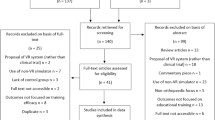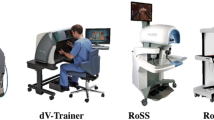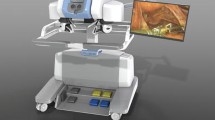Abstract
Background
Patient-specific virtual reality simulation (PSVR) is a new technological advancement that allows practice of upcoming real operations and complements the established role of VR simulation as a generic training tool. This review describes current developments in PSVR and draws parallels with other high-stake industries, such as aviation, military, and sports.
Methods
A review of the literature was performed using PubMed and Internet search engines to retrieve data relevant to PSVR in medicine. All reports pertaining to PSVR were included. Reports on simulators that did not incorporate a haptic interface device were excluded from the review.
Results
Fifteen reports described 12 simulators that enabled PSVR. Medical procedures in the field of laparoscopy, vascular surgery, orthopedics, neurosurgery, and plastic surgery were included. In all cases, source data was two-dimensional CT or MRI data. Face validity was most commonly reported. Only one (vascular) simulator had undergone face, content, and construct validity. Of the 12 simulators, 1 is commercialized and 11 are prototypes. Five simulators have been used in conjunction with real patient procedures.
Conclusions
PSVR is a promising technological advance within medicine. The majority of simulators are still in the prototype phase. As further developments unfold, the validity of PSVR will have to be examined much like generic VR simulation for training purposes. Nonetheless, similar to the aviation, military, and sport industries, operative performance and patient safety may be enhanced by the application of this novel technology.







Similar content being viewed by others
References
Kohn LT, Corrigan JM (2000) To err is human: building a safer health system by committee on quality of health care in America. Institute of Medicine, National Academies Press, Washington
Crossing the Quality Chasm: A New Health System for the 21st Century (2001) Committee on Quality of Health Care in America, Institute of Medicine, National Academies Press, Washington
Wachter R (2007) Understanding patient safety (LANGE Clinical Medicine). McGraw-Hill, New York
Willaert WI, Aggarwal R, Nestel DF et al (2010) Patient-specific simulation for endovascular procedures: qualitative evaluation of the development process. Int J Med Robot 6:202–210
Malone HR, Syed ON, Downes MS et al (2010) Simulation in neurosurgery: a review of computer-based simulation environments and their surgical applications. Neurosurgery 67:1105–1116
Bashir G (2010) Technology and medicine: the evolution of virtual reality simulation in laparoscopic training. Med Teach 32:558–561
Neequaye SK, Aggarwal R, Van Herzeele I et al (2007) Endovascular skills training and assessment. J Vasc Surg 46:1055–1064
Seymour NE (2008) VR to OR: a review of the evidence that virtual reality simulation improves operating room performance. World J Surg 2008(32):182–188
Chaer RA, Derubertis BG, Lin SC et al (2006) Simulation improves resident performance in catheter-based intervention: results of a randomized, controlled study. Ann Surg 244:343–352
Berger P, Willems MC, Van Der Vliet JA et al (2010) Validation of the Simulator for Testing and Rating Endovascular SkillS (STRESS)-machine in a setting of competence testing. J Cardiovasc Surg 51:253–256
Allerton D (2009) Principles of flight simulation. AIAA education series, vol 27. Wiley, Ben-Avi
Burdea G, Coiffet P (2003) Virtual reality technology, vol 1. Wiley-IEEE, New York
Ródenas J, Zarza I, Burgos MC et al (2007) Developing a virtual reality application for training nuclear power plant operators: setting up a database containing dose rates in the refueling plant. Radiat Prot Dosimetry 2111:173–180
http://www.getenergyevent.com/news/Oil_and_Gas_Training_News/PetroSims_Simulation_Training,_an_innovative_learning_solution. Accessed 4 April 2011)
Strickland, Jonathan. “How virtual reality military applications work.” http://science.howstuffworks.com/virtual-military.htm. Accessed 7 Feb 2011
Van Herzeele I, Aggarwal R, Neequaye S et al (2008) Experienced endovascular interventionalists objectively improve their skills by attending carotid artery stent training courses. Eur J Vasc Endovasc Surg 35:541–550
Krebs WK, McCarley JS, Bryant EV (1999) Effects of mission rehearsal simulation on air-to-ground target acquisition. Hum Factors 41:553–558
http://www.military-medical-technology.com/mt2-archives/109-mt2-2009-volume-14-issue-3/961-a-boost-for-mission-rehearsal.html. Accessed 7 Feb 2011
Air & Space Power Journal vol. 19, no. 4 (Winter 2005)
http://dx12.jsc.nasa.gov/site/index.shtml. Accessed 7 Feb 2011
http://www.nasa.gov/mission_pages/NEEMO/index.html. Accessed 7 Feb 2011
http://academy.grc.nasa.gov/y2007/tour-summaries/shuttle-mission-simulator. Accessed 7 Feb 2011
http://elianealhadeff.blogspot.com/2007/06/formula-one-leveraging-on-serious-games.html. Accessed 7 Feb 2011
http://mclaren.com. Accessed 7 Feb 2011
Soler L, Marescaux J (2008) Patient-specific surgical simulation. World J Surg 32:208–212
http://www.passport-liver.eu/Homepage.html. Accessed 7 Feb 2011
Marescaux J, Rubino F, Arenas M et al (2007) Augmented-reality-assisted laparoscopic adrenalectomy. JAMA 292:2214–2215
http://wwwvis.informatik.uni-stuttgart.de/vmv01/dl/posters/12.pdf. Accessed 10 Feb 2011
Forest C, Comas O, Vaysiere C et al (2007) Ultrasound and needle insertion simulators built on real patient-based data. Studies Health Technol Informat 125:136–139
Suzuki S, Eto K, Hattori A et al (2007) Surgery simulation using patient-specific models for laparoscopic colectomy. Stud Health Technol Inform 125:464–466
Sierra R, Dimaio SP, Wada J et al (2007) Patient specific simulation and navigation of ventriculoscopic interventions. Stud Health Technol Inform 125:433–435
http://www.nrc-cnrc.gc.ca/eng/news/nrc/2009/08/26/virtual-surgery.html. Accessed 10 Feb 2011
http://neurosurgery.medicine.dal.ca/files/SimulationNetworkNewsletter_September2010%20(2).pdf. Accessed 10 Feb 2011
Pettersson J, Palmerius KL, Knutsson H et al (2008) Simulation of patient specific cervical hip fracture surgery with a volume haptic interface. IEEE Trans Biomed Eng 55:1255–1265
Meehan M, Morris D, Maurer CR et al (2006) Virtual 3D planning and guidance of mandibular distraction osteogenesis. Comput Aided Surg 11:51–62
Schendel S, Montgomery K, Sorokin A et al (2005) A surgical simulator for planning and performing repair of cleft lips. J Craniomaxillofac Surg 33:223–228
Parikh SS, Chan S, Agrawal SK et al (2009) Integration of patient-specific paranasal sinus computed tomographic data into a virtual surgical environment. Am J Rhinol Allergy 23:442–447
Agus M, Giachetti A, Gobbetti E et al (2002) Mastoidectomy simulation with combined visual and haptic feedback. Stud Health Technol Inform 85:17–23
Cates CU, Patel AD, Nicholson WJ (2007) Use of virtual reality simulation for mission rehearsal for carotid stenting. JAMA 297:265–266
Willaert W, Aggarwal R, Harvey K, European Virtual Reality Endovascular Research Team (EVEResT) (2011) Efficient implementation of patient-specific simulated rehearsal for the carotid artery stenting procedure: part-task rehearsal. Eur J Vasc Endovasc Surg 42:158–166
Roguin A, Beyar R (2010) Real case virtual reality training prior to carotid artery stenting. Catheter Cardiovasc Interv 75:279–282
Hislop SJ, Hedrick JH, Singh MJ et al (2009) Simulation Case Rehearsals for Carotid Artery Stenting. Eur J Vasc Endovasc Surg 38:750–754
Willaert W, Aggarwal R, Bicknell C et al (2010) Patient-specific simulation in carotid artery stenting. J Vasc Surg 52:1700–1705
Willaert W, Aggarwal R, Daruwalla F et al (2010) Patient-specific rehearsal of a carotid artery stenting procedure results in superior operative performance compared to a preoperative generic warm-up. J Am Coll Surg 211(3):S142
Risser DT, Rice MM, Salisbury ML, Simon R et al (1999) The potential for improved teamwork to reduce medical errors in the emergency department. The MedTeams Research Consortium. Ann Emerg Med 34:373–383
Eadie LH, Seifalian AM, Davidson BR (2003) Telemedicine in surgery. Br J Surg 90:647–658
Satava RM (2009) How the future of surgery is changing: robotics, telesurgery, surgical simulators and other advanced technologies. J Chirurgie IAŞI 5
Acknowledgments
Willem Willaert is funded by a Clinical Doctoral Grant from the Fund for Scientific Research Flanders (FWO), Belgium. Rajesh Aggarwal is funded by a Clinician Scientist Award from the National Institute for Health Research, Department of Health, U.K.
Author information
Authors and Affiliations
Corresponding author
Additional information
This study was conducted on behalf of the European Virtual Reality Endovascular Research Team EVEResT.
Rights and permissions
About this article
Cite this article
Willaert, W.I.M., Aggarwal, R., Van Herzeele, I. et al. Recent Advancements in Medical Simulation: Patient-Specific Virtual Reality Simulation. World J Surg 36, 1703–1712 (2012). https://doi.org/10.1007/s00268-012-1489-0
Published:
Issue Date:
DOI: https://doi.org/10.1007/s00268-012-1489-0




